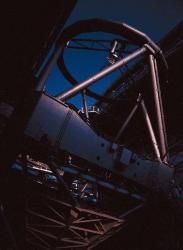 Even though gamma ray bursts are the most powerful known explosions in the Universe, you’ve got to move quickly if you want to capture useful science from them. A new press release from the European Southern Observatory goes into detail about how they work quickly to catch a burst’s fading light.
Even though gamma ray bursts are the most powerful known explosions in the Universe, you’ve got to move quickly if you want to capture useful science from them. A new press release from the European Southern Observatory goes into detail about how they work quickly to catch a burst’s fading light.
The first detection is made by NASA’s Swift satellite, which scans the skies, looking for the characteristic blast of gamma rays coming from a newly born black hole. The coordinates of the burst are transmitted via the Internet to observatories around the world. Within minutes, observatories, such as ESO’s Very Large Telescope (VLT) focus in on the blast and start recording.
ESO’s VLT took a series of images using the Ultraviolet and Visual Echelle Spectrograph (UVES) mounted on its Kueyen instrument. The overall response time is fast and getting faster. During a recent gamma ray burst that detonated on June 7, 2006, astronomers were able to focus in on the object a mere 7.5 minutes after it was detected by Swift.
Original Source: ESO News Release
